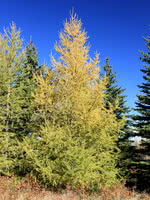Mon-Fri 9am - 5pm Mountain time
Common Hackberry vs Siberian Larch
Celtis occidentalis
Larix sibirica
The Common Hackberry is a medium-sized deciduous tree that resembles the American Elm but is immune to Dutch Elm Disease. They are versatile and can adapt to a variety of growing conditions.
It produces purple-red, berry-like fruit with a large seed in the center. Both the sweet flesh, which tastes similar to dates, and the crunchy seed are edible. The fruit remains on the tree throughout the winter, offering a valuable food source for birds and other wildlife.
The Common Hackberry can also be a great addition to a pollinator garden. The tree itself is a host for the larvae of several butterfly species and the flowers provide a source of pollen and nectar.
Siberian Larch is a large, cold hardy conifer. Like the Tamarack, its needles turn golden yellow and drop in the fall, and it is able to handle saturated soils.
If you are looking for a long-lived tree for your large property or shelterbelt with quite wet soil, this is the tree for you.
This variety is often used on the south side of a shelterbelt to let sunlight in during the winter and to provide protection or shading during the summer.

